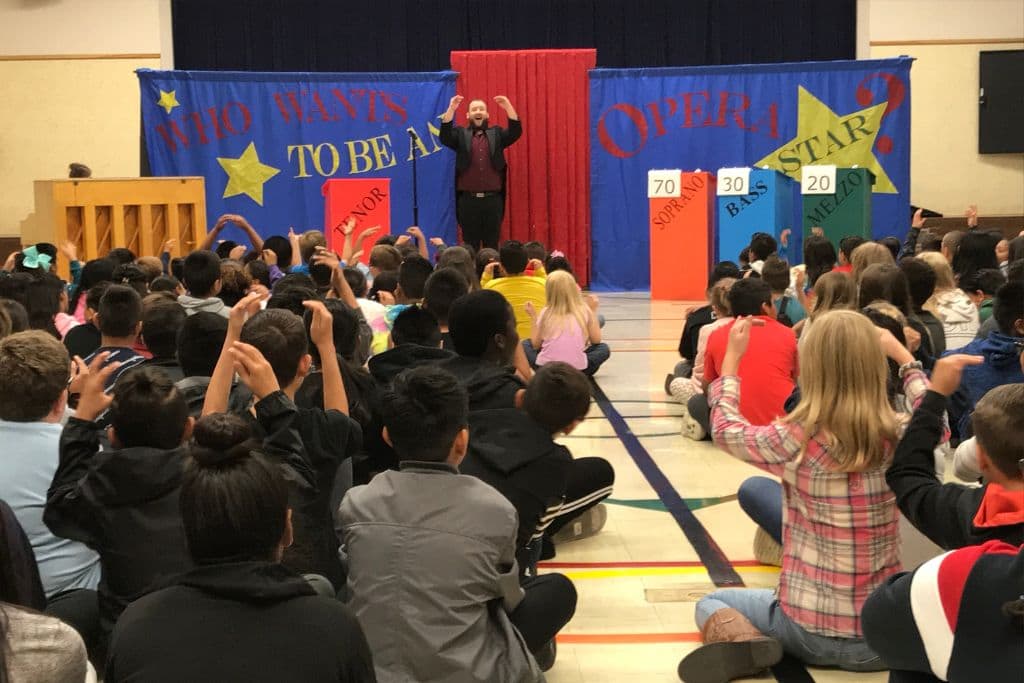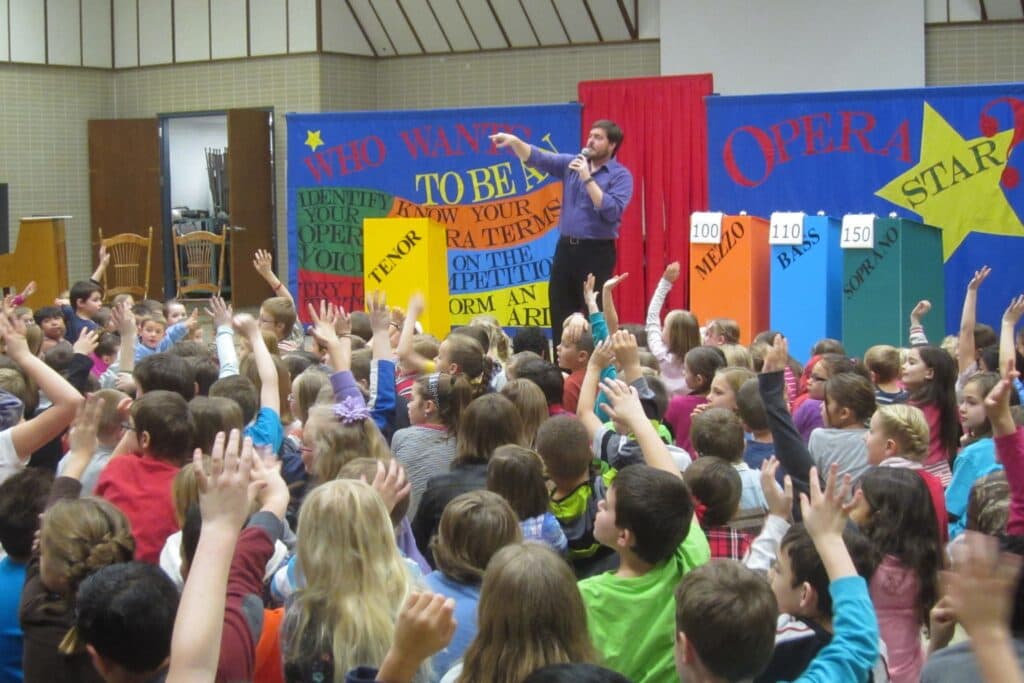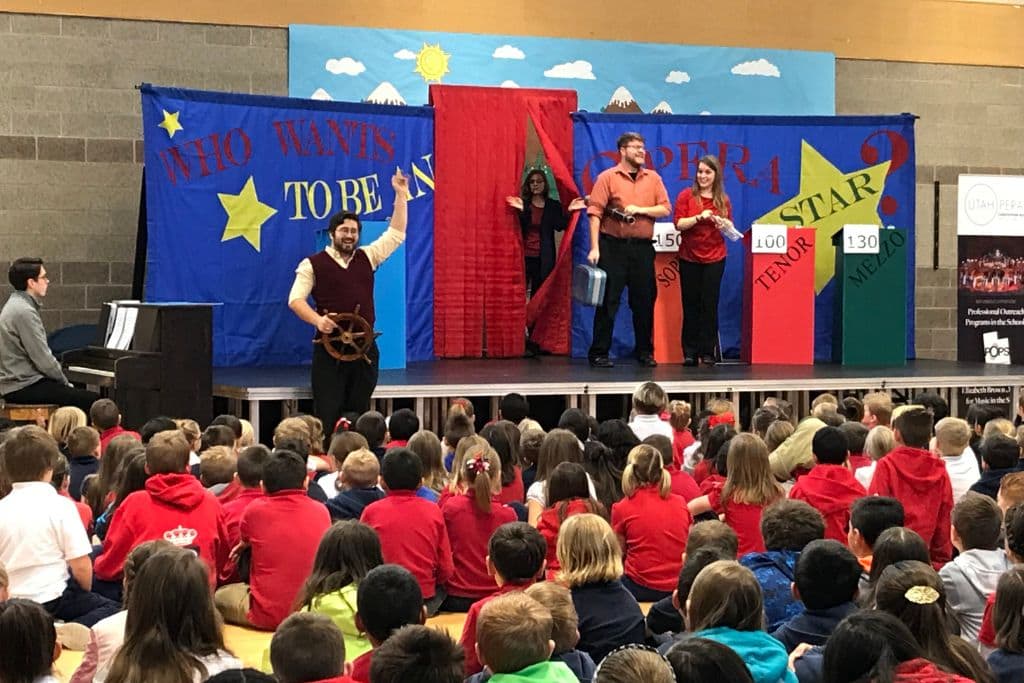Teacher Materials to accompany “Who Wants to Be an Opera Star?”
Hi teachers! Thanks for introducing your students to the wonderful world of Opera. The following materials are designed to supplement the “Who Wants to be an Opera Star?” elementary school assembly program.
Opera is the art form that combines drama, visual art, dance, orchestra music, and singing. Operas use words, action, and music to tell stories full of conflict and emotion, and they are usually entirely sung.
“Who Wants to be an Opera Star?” uses the framework of a television game show. The assembly runs as a series of questions and challenges, with four singers in the role of MC and contestants. Studio audience members (the students) will learn about voice types, arias, duets, trios, and quartets. Students will also participate in identifying emotions, singing melodies, and clapping rhythms from the world’s favorite operas.



Scroll to the bottom of the page to identify Utah Core Curriculum Connections for this assembly.
PRE-ASSEMBLY ACTIVITY OPTIONS
- Talk with students about the different kinds of “voices” each of them has:
Whispering voice Talking voice
Shouting voice Singing voice
Have students pair up and demonstrate for each other each of these different voices. Ask them to see if their partners can identify which voice they are using. What makes a singing voice different from other types of voices?
A special note about singing voices: Most children have high voices and would be called “sopranos,” but as they get older their voices will change, and many will get deeper. Some singers are comfortable singing very high, others sing better very low – it all depends on how their vocal muscles are built. From highest to lowest, the opera voice types are: soprano, mezzo-soprano, contralto, tenor, baritone, and bass.
Can your students think of a singer with a high voice, a low voice, or a mid-range voice?
- Practice clapping rhythms. You can clap along while singing a favorite song to identify its rhythm, or clap to the rhythm you hear on a recording (be sure to clap the rhythm of the melody, not just the regular beat), or even make up short rhythmic patterns and see if you can repeat back to each other the exact rhythm. The Opera Star performers will share a rhythm and ask students to repeat it back during the performance.
- Brainstorm a list of what students already know about opera. Ask them to pay attention during the assembly to add to or edit that list later.
POST-ASSEMBLY ACTIVITY OPTIONS
- Guide your class in a discussion about what they experienced during the assembly:
Ask students to evaluate/give their perceptions of the performers’ stage presence and music skills (these skills are part of the Utah Music & Theatre Core Standards – see specific list at the bottom of this webpage).
Ask students to describe their favorite scenes from the assembly, and explain why they liked those scenes the best (these skills are part of the National Standards for Music Education).
Ask students what they learned about opera.
- If your students brainstormed a list about opera before the assembly, go back through the list together, checking for accuracy and adding important elements they hadn’t known about before.
- We also want teacher feedback! Fill out this brief teacher survey so we can improve our assembly for future schools.
- If students or teachers have lingering questions after the assembly, write to our artists:
Submit a question online at Ask a Question of an Artist/Pianist, and one of our artists will respond by email.
Write a letter or card with questions or impressions of opera at:
Utah Opera Education
336 North 400 West
Salt Lake City, UT 84103
Our artists love receiving fan mail, and will respond to your questions.
LEARN MORE AND WATCH MORE OPERA
- Learn more about opera singers by watching videos about different voice types.
CORE CURRICULUM CONNECTIONS in Music and Theatre
The Utah Opera Resident Artists are inspirational examples of what students can achieve when they master the Utah State Core Standards for Music. The assembly can aid classroom teachers and arts specialists teach both the music and theatre core.
Music:
- Did the singers know how to start and stop their musical numbers together?
- Did the singers sing with “voices free from strain”?
- Can students recognize and remember times when the singers used musical skills such as different pitches, rhythms, and dynamics (loud or soft)?
Theatre:
- Did the artists use clear voices when communicating? Did you notice differences in intensity, pitch, rhythm, and volume?
- Each artist played a character in a game show. What did each character want, and what prevented them from getting it? Could you write an inner dialogue for one of these characters?
- What did you think of how the actors moved around the stage (the blocking) for the scenes?
- Explain how this presentation is different from a theatre performance.


